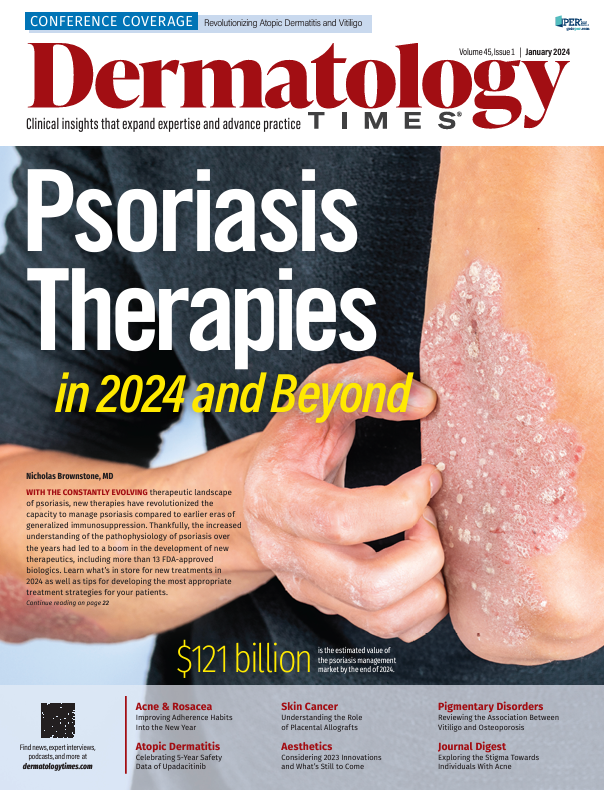- Case-Based Roundtable
- General Dermatology
- Eczema
- Chronic Hand Eczema
- Alopecia
- Aesthetics
- Vitiligo
- COVID-19
- Actinic Keratosis
- Precision Medicine and Biologics
- Rare Disease
- Wound Care
- Rosacea
- Psoriasis
- Psoriatic Arthritis
- Atopic Dermatitis
- Melasma
- NP and PA
- Skin Cancer
- Hidradenitis Suppurativa
- Drug Watch
- Pigmentary Disorders
- Acne
- Pediatric Dermatology
- Practice Management
- Prurigo Nodularis
- Buy-and-Bill
News
Article
Dermatology Times
Hello, 2024! What Surprises Are in Store for Dermatology This Year?
Author(s):
Winter Editor in Chief Christopher Bunick, MD, PhD, looks ahead to a year of dermatology innovations with a reflection on meaningful advances from 2023.
If 2024 is anything like 2023, it will move fast but will be filled with new innovations, advances in patient care, and camaraderie among colleagues. 2023 was a welcome return to normalcy for most dermatology providers as patients packed clinics and the COVID-19 pandemic and its restrictions seemed more like a distant memory. Let’s revisit a few therapeutic highlights from 2023, and then look forward to 2024 and discuss some New Year’s resolutions for the dermatology specialty.

In an end-of-2023 burst, the FDA approved the long-awaited biologic bimekizumab, a dual IL-17A and IL-17 inhibitor, for plaque psoriasis. Shortly thereafter, the IL-17A inhibitor secukinumab (Cosentyx) was FDA approved for hidradenitis suppurativa (HS), bringing a much needed on-label addition to the advanced therapies available for patients with HS. There was also a new FDA approval for the fixed-dose triple-combination gel of clindamycin, adapalene, and benzoyl peroxide for the treatment of the most common condition seen in all of dermatology: acne vulgaris. “Old” can be “good”, and “3-in-1” will be a common phrase from dermatologist to patients with acne in 2024.
Throughout 2023, the dermatology community focused intensively on the real-world applications and benefits of Janus kinase (JAK) inhibitors for treating various conditions, such as atopic dermatitis, vitiligo, HS, alopecia areata, and psoriasis (TYK2). These inhibitors, a new class of therapies, have significantly impacted dermatology and are expected to be a mainstay in treatment options. The remarkable efficacy of upadacitinib and abrocitinib, particularly in atopic dermatitis, has raised treatment standards. The scope of JAK inhibitors further expanded with the approval of ritlecitinib for alopecia areata, underscoring their growing importance in dermatology. Discussions about gaining proficiency and confidence in using JAK inhibitors were prevalent at major dermatology meetings, including the American Academy of Dermatology (AAD) Annual Meeting in New Orleans, Louisiana and the 25th World Congress of Dermatology (WCD) meeting in Singapore. The positive safety profile of these inhibitors, especially when compared to traditional immunosuppressants, along with long-term safety data, has significantly reassured both clinicians and patients.
In the realm of wound healing, 2023 marked a pivotal moment with the FDA’s approval of the first topical gene therapy, beremagene geperpavec. This groundbreaking treatment is designed for both recessive and dominant forms of dystrophic epidermolysis bullosa, a rare and serious genetic condition that affects the skin and mucosal tissues. This approval represents a significant advancement in the treatment of this debilitating blistering disease.
What new therapies or indications might we see in 2024? First, seborrheic dermatitis is seen every day in every medical dermatology clinic—probably the aesthetic clinic, too—but its treatment is limited by a lack of effective nonsteroidal therapies. The expected approval of the potent PDE4 inhibitor roflumilast will potentially revolutionize the ability to tackle seborrheic dermatitis refractory to topical steroids and/or antifungals. Second, there is currently no FDA-approved therapy for the rare genetic disease congenital ichthyosis (CI); however, there is hope for topical isotretinoin to be effective for the treatment of X-linked recessive CI and autosomal recessive lamellar CI. The phase 3 trial is nearing completion and initial data are expected to be presented at the 2024 AAD Annual Meeting in San Diego, California. Third, it is possible we’ll see the FDA approval of 2 new medicines into the atopic dermatitis therapeutic toolbox: nemolizumab (an anti–IL-31 receptor a monoclonal antibody) and lebrikizumab (a second IL-13 targeted biologic). Beyond these, numerous clinical trials for new, creative therapies are ongoing, and these trial results will undoubtedly be anticipated and discussed at meetings throughout the year.
Perhaps one of the more field-defining events of 2024 will not be an FDA therapeutic approval, but rather the FDA banning formaldehyde (FA) and FA-releasing chemicals from hair smoothening/straightening products. The FDA proposed the ban in October 2023 but looks to make it effective in April 2024. Their rationale is that FA and FA-releasing chemicals pose both short-term (breathing problems, sensitization reactions) and long-term (uterine and potentially other cancers) health risks to humans. The ban has been 7 years in the making, which seems like a long time given that FA is listed as a Group 1 known human carcinogen by both the International Agency for Research on Cancer and the American Cancer Society. The reason this ban is so important is that it may set precedent for how the FDA regulates potential carcinogens present in other cosmetic and personal hygiene products, such as benzene, which is also a Group 1 carcinogen just like FA.
With a new year comes new hopes, new goals, new dreams, and a clean slate; for some, it even means New Year’s resolutions. Although most people may forget about their resolution(s) by Valentine’s Day, Dermatology Times won’t let that happen to dermatology. Here are some resolutions for dermatology in 2024:
- First and foremost, we are a specialty driven by patient care. Thus, we should resolve to be more empathetic with our patients in 2024. Can we go the extra mile for a patient just like we might for our own family member?
- Education of the next generation of dermatologists is critical for our specialty to grow and flourish. Can we all find at least 1 person—student, resident, or colleague—and provide meaningful mentorship?
- Economic challenges remain real for all providers, including reimbursement reduction at a time when inflation increases the overhead cost of business. Can we work together as a specialty, along with leadership at the American Academy of Dermatology, to protect our livelihood at the legislative level?
- Lastly, read more Dermatology Times! In return, Dermatology Times’ New Year’s resolution to its readers and the specialty as a whole— physicians, nurse practitioners, and physician assistants— is to provide accurate, detailed reports on cutting-edge issues throughout the medical and aesthetic areas of dermatology
Christopher Bunick, MD, PhD, is an associate professor of dermatology and physician-scientist at the Yale School of Medicine in New Haven, Connecticut. He is also the Dermatology Times Winter Editor in Chief in 2024.







